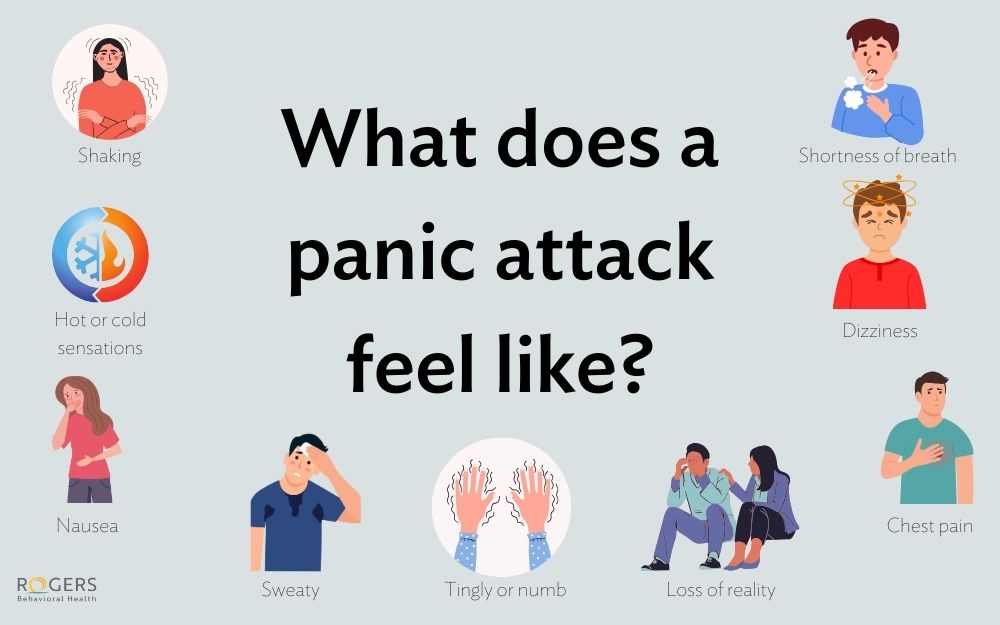By Simon Jencius, MS, LCPC, clinical supervisor, Rogers Behavioral Health in Hinsdale
While panic attacks can be frightening, understanding symptoms and learning coping strategies can help people manage them with more confidence and control.
What is a panic attack?
They are a sudden and intense rush of fear that begin without warning. A person experiences physical symptoms, which their mind misinterprets as something dangerous or threatening is happening. They can be overwhelming and leave someone feeling shaken and vulnerable. A panic attack can happen at any time — at home, the grocery store, or the office during a business meeting.
Many people have one or two in their lifetimes which are usually triggered by a stressful situation. Others who have recurrent, unexpected panic attacks and spend long periods in constant fear of another attack may have a condition called panic disorder. Both panic attacks and panic disorders are very treatable, so there is hope.
While we don’t know what causes panic attacks, genetics or stress may play a part.
What does a panic attack feel like?
Panic attacks typically last a few minutes, although they can differ from person to person. Physical symptoms typically include:
- Shaking
- Hot or cold sensations
- Tingly lips or fingers
- Numbness
- Loss of reality
- Dizziness or fainting
- Nausea
- Sweating
- Shortness of breath
- Chest pain
These physical symptoms can cause a person to feel as though they’re:
- Losing control
- Having a heart attack
- Dying
It’s important to see a doctor if you’re experiencing these symptoms to rule out a medical condition that may need attention.
Feelings of stress and anxiety often accompany panic attacks, and people tend to cope in unhelpful ways, including:
- Avoiding situations. A person won’t drive any roads under construction in case they get stuck in traffic and have a panic attack.
- Seeking reassurance. Asking a friend if they’re going to be okay if they decide to do a certain thing because they fear having a panic attack.
- Using safety behaviors. Examples include checking, asking for reassurance, and fidgeting.
- Distracting themselves. This includes listening to music, playing video games, changing the topic, being on their phone, and talking with others.
- Repeating certain actions to eliminate feelings of stress and anxiety that accompany panic attacks. An example is saying a prayer every time a person leaves the house or knocking on wood three times.
Additionally, people can be anxious about the possibility of future panic attacks.
Are panic attacks dangerous?
While they cause a person to think and feel that they’re in danger and they’re very uncomfortable, a panic attack in of itself is not dangerous and will not cause the person experiencing it physical harm.
What can a person do during a panic attack?
When someone is experiencing a panic attack and medical conditions have been ruled out, I suggest several strategies to help manage it—techniques I regularly teach to those I work with:
- Sit with it until the physical symptoms disappear. It’s important to remember a panic attack typically lasts a few minutes.
- Monitor the amount of time and level of discomfort.
- Remember that although panic attacks may feel dangerous or even life threatening, they are not.
When should a person seek professional support and what would that look like?
A person should seek help when intense fear and worry about having more panic attacks begin to interfere with their quality of life and prevent them from fully participating in daily life.
It’s important to work with someone who uses cognitive behavioral therapy (CBT) and exposure and response prevention (ERP) to treat anxiety and panic disorder. Additionally, interoceptive exposures are extremely helpful. This simply means using exercises to recreate the physical sensations a person experiences during a panic attack that are causing fear, and learning how to effectively handle them.
Additional resources
There are several free and very helpful resources available about panic attacks. For additional information, check out:
- American Psychological Association (APA)
- International OCD Foundation
- Association for Behavioral and Cognitive Therapies (ABCT)
Rogers offers compassionate care
If you or a loved one is suffering from OCD, anxiety, depression or other mood disorder, eating disorder, substance use, or trauma, we’re here to help. To get started, call 800-767-4411.


